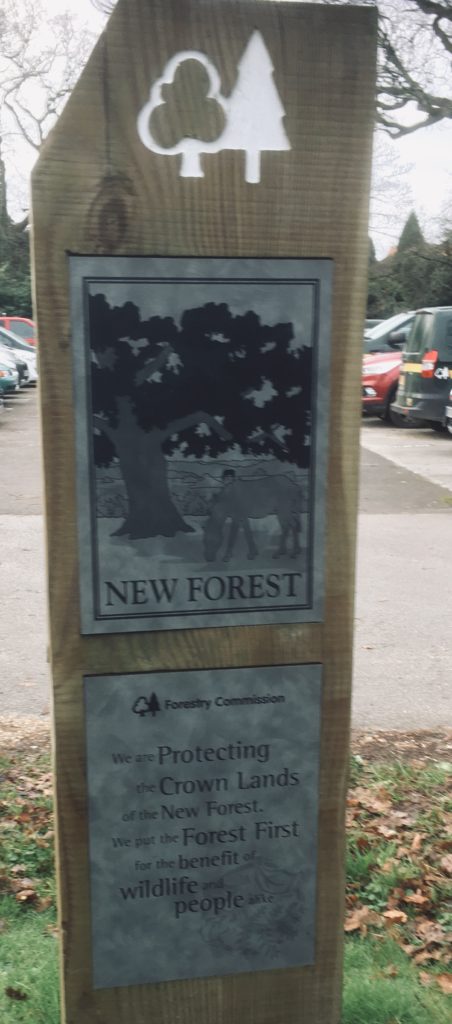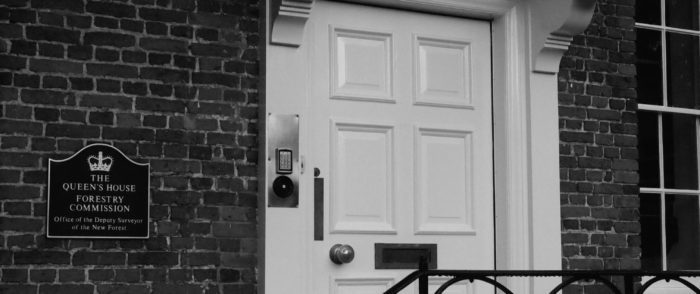Forestry England celebrates 100 years: Back to the Future
Forestry England “celebrates” its centenary this year. It will be much less of a celebration amongst those who care for the New Forest. Austerity has seen significant real cuts to Forestry England’s budget in recent years, although it still receives some £45 million of taxpayers’ money to carry out its core work. The New Forest is paying a heavy price as Forestry England seeks to maximise revenue and minimise its costs. Far from putting the Forest first it is turning back the clock to its original purpose of profit instead of protection.
 The origins of Forestry England lie in the devastating exploitation of the New Forest. But around the start of the 21st century it came to appreciate the fragility of the landscape and the commoning system upon which it depends. Its own Land Agent produced the “Illingworth Report” for the government in 1991, seeking ways to sustain the grazing of the New Forest, and upon which everything else depends. But now it appears to be returning to its exploitative, uncaring roots. It is becoming a typical large-scale landlord: Distant, disinterested, and non-communicative. Anyone who has tried to contact Forestry England outside of office hours will know full well the low level of attention.
The origins of Forestry England lie in the devastating exploitation of the New Forest. But around the start of the 21st century it came to appreciate the fragility of the landscape and the commoning system upon which it depends. Its own Land Agent produced the “Illingworth Report” for the government in 1991, seeking ways to sustain the grazing of the New Forest, and upon which everything else depends. But now it appears to be returning to its exploitative, uncaring roots. It is becoming a typical large-scale landlord: Distant, disinterested, and non-communicative. Anyone who has tried to contact Forestry England outside of office hours will know full well the low level of attention.
Forestry England appears to have reversed the three objectives set out in the Minister’s Mandate for its management of the Crown lands. The primary objective of conservation is now subservient to the third objective of income generation and efficient management. In the Ministers Mandate it is made explicit that Forestry England’s commercial interest must only be pursued where it is consistent with conservation: “Forest First” is the official mantra. In truth, the book-keepers of Forestry England’s Bristol HQ are now the priority, not this precious landscape which they are paid by taxpayers to conserve.
The most blatant example of the new commercial agenda has been in the total disregard for government policy on the management of Crown properties within the Forest. For generations these have provided the bedrock of commoning: The Commission providing employment, and smallholdings for rent, for commoners. As commercial forestry declines the policy requires that these are prioritised to continue to support commoning, made available to commoners (whether Commission employees or not) at affordable rents. In October 2017 ministers reminded Forestry England that policies can only change if ministers decide to do this. This has been ignored completely. Instead it has continued to move all properties to unaffordable market rents, approaching £2000 a month, and prioritising their use as a perk for its own employees. It is setting rents that are at least 70% of average local household incomes, and more than 100% of most young commoners’ incomes. This is no different to a local authority deciding to hand social housing to its managers. In just three months at the end of 2018 the keys for three commoners’ holding were handed to Commission staff, none of whom were commoners. Others are standing empty, but the desire to maximise revenues gives little hope of any being used to support the continuation of commoning.
In 2006 DEFRA ministers stated that the proportion of cottages rented to commoners would increase. It is now in rapid decline. In the past three months alone three excellent commoners’ holdings have been handed to Forestry England employees, who have been told that they will go on the open market if not taken up at rents of £18-24,000 a year. It is now advertising a cottage for £1450 a month for commoners with a minimum of 10 ponies, yet providing little more than one acre of back-up. The criteria are as arbitrary as the rent. It is designed to fail so they can take it onto the holiday homes market. The CDA have been discussing these concerns with Forestry England for three years, but they have ploughed on with the new strategy regardless. It is hard to overstate the damage being done to the sustainability of the New Forest landscape by the loss of these prime commoning holdings. The cottages were retained in these locations for a purpose, but one by one commoners are being forced out of the Forest and the direct contribution of these properties to the local Forest is being lost. Forestry England argues that extreme property values in the New Forest mean that affordable rents are nothing more than an intolerable “opportunity cost” for its Bristol book-keepers, that anything below open market rents is an unaffordable subsidy. For commoners who subsidise their livestock through their own time and income, and whose taxes fund Forestry England, these claims add insult to injury.
The unilateral abandonment of a “Forest First” strategy is also visible in the increasingly aggressive management of its campsites in the New Forest. According to recent Annual Reports for Camping in the Forest LLP, the “key strategic focus” for this new joint venture for the campsites on the Open Forest SSSI is to “grow pitch nights”, against which the protected status of this land is described as the “principle risk” facing the business.
In 2019 Forestry England celebrates its centenary, with its latest rebranding from Forestry Commission. It seems that it is also reverting to its original 1919 mission, to simply maximise its exploitation of the landscape. The New Forest seems to be little more than a local irritation, that requires financial support, diverting the agency from its relentless pursuit of revenues. In 2011 the country thought it had fought off forest privatisation. It now seems that the same outcome is being achieved under the radar. No-one within the Forestry Commission seems able to act as a voice for the New Forest, and the Minister’s Mandate is simply withering on the vine.
Commoners have fought off similar threats over centuries. We have no intention of standing by and letting them happen today.
10 FACTS ABOUT THE CROWN HOLDINGS IN THE NEW FOREST
- There are around 65 Crown properties in the New Forest, originally built for forestry, and now managed by Forestry England on behalf of the Department of the Environment, Food and Rural Affairs
- In the late 1980s a thorough New Forest review for Government concluded that the best way to maintain the New Forest landscape was to support the vocational system of small-scale commoning. The Illingworth Report set a policy, endorsed by ministers, that forestry properties in the New Forest would be retained to provide bases for commoning and rented to them at 15% of income given the local disparity between incomes and rents.
- This policy was repeated in 2006, when DEFRA minister, Ben Bradshaw, said that the cottages had been retained for commoning, and that an increasing proportion would be allocated to commoners as Forestry operational needs decline
- In 2016 Forestry England unilaterally declared a policy to move land and holdings towards market rents for all tenants
- In October 2017 DEFRA minister Dr Therese Coffey responded to a question from Desmond Swayne MP (New Forest West) confirming that any change from the Illingworth policy would require full consultation and a proposal put to ministers for approval
- In July 2018 the Assistant Land Agent emailed all local Forestry England staff offering currently vacant cottages at rents between £18000 and £24,000 per annum, regardless of local operational need, and with no preference for staff who would graze livestock from the holdings. The email stated that any holdings left would then be let on the “open market”, with no mention of commoning. This email was leaked to us.
- In May 2019, under pressure from the CDA, Forestry England decided to offer one smallholding to commoners, by a tender process with an advertised price of £18,000 a year. They imposed a requirement to graze 10 ponies, despite the holding having just 1 acre of back-up land and three pony stables, grossly insufficient for the care of 10 animals. They also chose to separate the barn from the property in order seek a commercial tenant, leaving the holding with no facility for the storage of hay or equipment.
- For three years the CDA has sought to discuss this matter with Forestry England and been willing to update the Illingworth policies to reflect changes in the housing market. Forestry England have simply continued to implement its open market and market rent policies
- The average local property value in the New Forest has now reached a multiple of 15.9 times average local income. The national park premium for a property within the New Forest is now £300,000. It is Britain’s least affordable national park
- In May 2019 the New Forest Trust charity obtained planning permission for one small rental holding, which will be built after a local fundraising campaign, and which is already heavily oversubscribed by young commoners in need of an affordable base within the New Forest.

Members Login
 Latest Tweets
Latest Tweets
Follow us
@realnewforest 4h
Icilibus sam quas aut eriatem nume corepta auta conet officaborem quodi corepta auta conet officaborem quodi apernat ectlpa dolorpiaecus.
@realnewforest 4h
Icilibus sam quas aut eriatem nume corepta auta conet officaborem quodi corepta auta conet officaborem quodi apernat ectlpa dolorpiaecus.
@realnewforest 4h
Icilibus sam quas aut eriatem nume corepta auta conet officaborem quodi corepta auta conet officaborem quodi apernat ectlpa dolorpiaecus.
With thanks for support from




